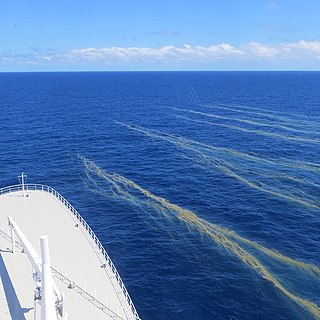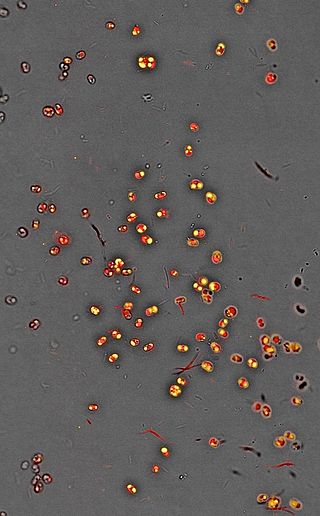
A lipoprotein is a biochemical assembly whose primary function is to transport hydrophobic lipid molecules in water, as in blood plasma or other extracellular fluids. They consist of a triglyceride and cholesterol center, surrounded by a phospholipid outer shell, with the hydrophilic portions oriented outward toward the surrounding water and lipophilic portions oriented inward toward the lipid center. A special kind of protein, called apolipoprotein, is embedded in the outer shell, both stabilising the complex and giving it a functional identity that determines its role.
A polyphosphate is a salt or ester of polymeric oxyanions formed from tetrahedral PO4 (phosphate) structural units linked together by sharing oxygen atoms. Polyphosphates can adopt linear or a cyclic (also called, ring) structures. In biology, the polyphosphate esters ADP and ATP are involved in energy storage. A variety of polyphosphates find application in mineral sequestration in municipal waters, generally being present at 1 to 5 ppm. GTP, CTP, and UTP are also nucleotides important in the protein synthesis, lipid synthesis, and carbohydrate metabolism, respectively. Polyphosphates are also used as food additives, marked E452.

Trichodesmium, also called sea sawdust, is a genus of filamentous cyanobacteria. They are found in nutrient poor tropical and subtropical ocean waters. Trichodesmium is a diazotroph; that is, it fixes atmospheric nitrogen into ammonium, a nutrient used by other organisms. Trichodesmium is thought to fix nitrogen on such a scale that it accounts for almost half of the nitrogen fixation in marine systems globally. Trichodesmium is the only known diazotroph able to fix nitrogen in daylight under aerobic conditions without the use of heterocysts.

Polyhydroxyalkanoates or PHAs are polyesters produced in nature by numerous microorganisms, including through bacterial fermentation of sugars or lipids. When produced by bacteria they serve as both a source of energy and as a carbon store. More than 150 different monomers can be combined within this family to give materials with extremely different properties. These plastics are biodegradable and are used in the production of bioplastics.

Pulmonary surfactant is a surface-active complex of phospholipids and proteins formed by type II alveolar cells. The proteins and lipids that make up the surfactant have both hydrophilic and hydrophobic regions. By adsorbing to the air-water interface of alveoli, with hydrophilic head groups in the water and the hydrophobic tails facing towards the air, the main lipid component of surfactant, dipalmitoylphosphatidylcholine (DPPC), reduces surface tension.

Oedogonium is a genus of filamentous, free-living green algae. It was first discovered in the fresh waters of Poland in 1860 by W. Hilse, and later given its name by German scientist K. E. Hirn.

Oscillatoria is a genus of filamentous cyanobacteria. It is often found in freshwater environments. Its name refers to the oscillating motion of its filaments as they slide against each other to position the colony to face a light source. Oscillatoria uses photosynthesis to survive and reproduce. Each filament of Oscillatoria consists of a row of cells called a trichome. The tip of the trichome oscillates like a pendulum.

Synechococcus is a unicellular cyanobacterium that is very widespread in the marine environment. Its size varies from 0.8 to 1.5 μm. The photosynthetic coccoid cells are preferentially found in well–lit surface waters where it can be very abundant. Many freshwater species of Synechococcus have also been described.

Botryococcus is a genus of green algae. It is a microscopic or semi-microscopic alga that is found in freshwater habitats worldwide. It consists of colonies of cells in an irregular, gelatinous matrix.

Nannochloropsis is a genus of algae comprising six known species. The genus in the current taxonomic classification was first termed by Hibberd (1981). The species have mostly been known from the marine environment but also occur in fresh and brackish water. All of the species are small, nonmotile spheres which do not express any distinct morphological features that can be distinguished by either light or electron microscopy. The characterisation is mostly done by rbcL gene and 18S rRNA sequence analysis.

Scytonema is a genus of photosynthetic cyanobacteria that contains over 100 species. It grows in filaments that form dark mats. Many species are aquatic and are either free-floating or grow attached to a submerged substrate, while others species grow on terrestrial rocks, wood, soil, or plants. Scytonema is a nitrogen fixer, and can provide fixed nitrogen to the leaves of plants on which it is growing. Some species of Scytonema form a symbiotic relationship with fungi to produce a lichen.

Planktothrix is a diverse genus of filamentous cyanobacteria observed to amass in algal blooms in water ecosystems across the globe. Like all Oscillatoriales, Planktothrix species have no heterocysts and no akinetes. Planktothrix are unique because they have trichomes and contain gas vacuoles unlike typical planktonic organisms. Previously, some species of the taxon were grouped within the genus Oscillatoria, but recent work has defined Planktothrix as its own genus. A tremendous body of work on Planktothrix ecology and physiology has been done by Anthony E. Walsby, and the 55.6 kb microcystin synthetase gene which gives these organisms the ability to synthesize toxins has been sequenced. P. agardhii is an example of a type species of the genus. P. agardhii and P. rubescens are commonly observed in lakes of the Northern Hemisphere where they are known producers of potent hepatotoxins called microcystins.

Nannochloropsis is a genus of alga within the heterokont line of eukaryotes, that is being investigated for biofuel production. One marine Nannochloropsis species has been shown to be suitable for algal biofuel production due to its ease of growth and high oil content, mainly unsaturated fatty acids and a significant percentage of palmitic acid. It also contains enough unsaturated fatty acid linolenic acid and polyunsaturated acid for a quality biodiesel.
Trichodesmium thiebautii is a cyanobacteria that is often found in open oceans of tropical and subtropical regions and is known to be a contributor to large oceanic surface blooms. This microbial species is a diazotroph, meaning it fixes nitrogen gas (N2), but it does so without the use of heterocysts. T. thiebautii is able to simultaneously perform oxygenic photosynthesis. T. thiebautii was discovered in 1892 by M.A. Gomont. T. thiebautii are important for nutrient cycling in marine habitats because of their ability to fix N2, a limiting nutrient in ocean ecosystems.

Dictyota is a genus of brown seaweed in the family Dictyotaceae. Species are predominantly found in tropical and subtropical seas, and are known to contain numerous chemicals (diterpenes) which have potential medicinal value. As at the end of 2017, some 237 different diterpenes had been identified from across the genus.
Zobellella denitrificans is a gram-negative, facultatively anaerobic, heterotrophic and denitrifying bacterium from the genus of Zobellella which has been isolated from sediments from a mangrove ecosystems from Miaoli County in Taiwan.
Heteroleibleinia is a genus of algae belonging to the family Pseudanabaenaceae.
Jaaginema is a genus of cyanobacteria belonging to the family Pseudanabaenaceae.

Komvophoron is a genus of cyanobacteria belonging to the family Borziaceae.
An oleaginous microorganism is a type of microbe that accumulates lipid as a normal part of its metabolism. Oleaginous microbes may accumulate an array of different lipid compounds, including polyhydroxyalkanoates, triacylglycerols, and wax esters. Various microorganisms, including bacteria, fungi, and yeast, are known to accumulate lipids. These organisms are often researched for their potential use in producing fuels from waste products.














